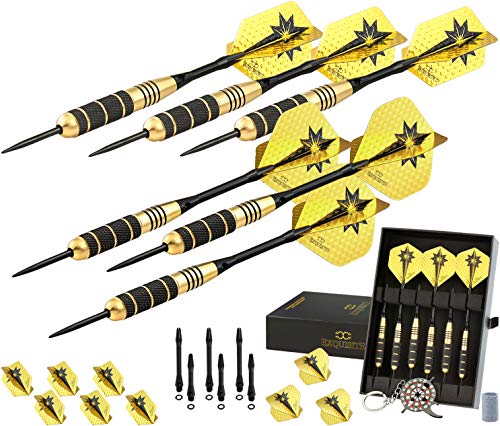How to Choose the Darts
A Comprehensive Guide to Darts: Everything You Need to Know

- 1. A Comprehensive Guide to Darts: Everything You Need to Know
- 1.1. History of Darts
- 1.2. Darts Equipment
- 1.2.1. Dartboard
- 1.2.2. Darts
- 1.2.3. Throwing Area
- 1.3. How Do You Know What Set Of Darts Is Right For You?
- 1.3.1. Steel or soft tip?
- 1.3.2. Budget
- 1.3.3. Material
- 1.3.4. Weight
- 1.3.5. Length and shape
- 1.3.6. Grip
- 1.3.7. Shafts
- 1.3.8. Flights
- 1.3.9. Accessories
- 1.4. Techniques and Strategies
- 1.4.1. Stance and Grip
- 1.4.2. Aiming and Targeting
- 1.4.3. Practice
- 1.5. Conclusion
If you've developed a passion for the captivating game of darts, it's likely a good moment to explore acquiring your own set of darts. However, rather than simply buying any set, it's essential to ensure that you choose a set that aligns with your preferences. The world of darts offers a considerable range of options, and this guide is designed to offer you in-depth insights into the key factors you should take into account when making your dart selection.
History of Darts
Darts has its roots in 19th-century England, where it initially emerged as a pastime for soldiers tossing short arrows at the base of casks or tree trunks. As the game progressed, standardized rules were introduced, leading to its evolution. Nowadays, darts has transcended its humble origins and has emerged as a widely acknowledged sport with organized leagues and tournaments that draw participants and enthusiasts from across the globe.
Darts Equipment
Dartboard
The dartboard is a circular target divided into numbered sections. The standard dartboard is divided into 20 numbered sections, each with a point value. The most common type is the "clock" dartboard, with the bullseye at the center.
Darts
Darts typically consist of a steel or tungsten barrel, a flight, and a shaft. The weight and style of darts can vary based on personal preference, but they must adhere to specific regulations regarding length, weight, and shape.
Throwing Area
The oche or throwing line is the distance from the front of the board to the player, typically 7 feet 9.25 inches (2.37 meters) for soft-tip darts and 7 feet 6 inches (2.29 meters) for steel-tip darts.
How Do You Know What Set Of Darts Is Right For You?
Choosing the right dart involves taking various factors into account. Whether you're buying your initial set or looking to upgrade, if you're unsure about where to start in the process of acquiring darts, this list will guide you in making the optimal decision.
Steel or soft tip?
Before delving into the search for a new set of darts, the initial decision revolves around choosing between steel or soft tip darts. For most, this choice is dictated by the playing environment – be it at home, in a pub, or within a league. Select darts that suit your board, and stick with them, whether you're aiming for precision in a casual setting or engaging in a competitive league.
Budget
While price is a crucial consideration when selecting darts, it doesn't necessarily determine the quality of your darting experience. Spending more doesn't always translate to a better playing experience or improved skills. Higher-priced darts may offer superior construction and premium materials, potentially enhancing your gameplay and investment longevity. However, flashy aesthetics may inflate costs without adding substantial benefits. On the flip side, cheaper sets may lack consistency, affecting precision. Ultimately, your playing ability outweighs the depth of your wallet. Many experts opt for budget-friendly darts, emphasizing the importance of thoughtful decision-making.
Material
When making a decision about a dart barrel, it's essential to consider the material used in its construction. The choice of material holds significance as it directly influences crucial aspects such as weight, size, durability, and overall feel. Brass, nickel, tungsten, or a combination of metals are the most commonly employed materials for crafting dart barrels.
- Brass barrels, while often the least expensive option, lack durability.
- Nickel barrels tend to be more durable but come with a higher price tag.
- Tungsten barrels are highly favored in professional settings due to the unique physical properties of the metal.
The density of tungsten allows manufacturers to create narrower barrels, enabling closer groupings without compromising the dart's weight. Unless you specifically prefer the feel of a larger dart, the majority of individuals opt for tungsten for its desirable characteristics.
Weight
One of the most variable and individual factors influencing your performance is the weight of your darts. Every player must meticulously choose the weight of their dart to align with their unique throwing style.
Heavier darts typically travel in a more straight path through the air. Players with advanced skills should opt for heavier darts, as they demand greater precision. Conversely, lighter darts follow a more parabolic trajectory, making them an excellent choice for beginners who prioritize ease over precision.
Nevertheless, these preferences are not set in stone, and experts might lean towards lighter darts while novices may prefer heavier ones. The most effective way to determine the suitable dart weight is to spend some time playing games with darts of various weights until you find the one that feels optimal.
Dart weights commonly range from 16 to 26 grams; however, recent regulations permit darts to weigh up to 50 grams.
Ideally, starting with darts weighing around 20 to 24 grams is recommended. These weights are most commonly used and offer the flexibility to transition to heavier or lighter options. If you tend to throw darts too high, opting for heavier darts is advisable, and vice versa.
Length and shape
Similar to weight, the length and shape of the dart barrel are also subjective choices. Darts are available in various shapes and sizes, ranging from short torpedo styles to long, slender cylinders. The selection of barrel size is influenced by the size of your hands and your preferred dart-holding technique. In general, if you use more fingers in your grip, you may prefer a longer barrel, unless you prefer gripping with your fingers resting on the tip.
Opting for a longer barrel provides more gripping space for the dart, while shorter barrels limit grip options. The shape of your dart significantly impacts weight distribution, influencing how the dart flies. The dart's shape determines whether it is balanced or front-heavy, which is a crucial factor for dart flight.
Professional players often choose slimmer barrels, as they allow for more darts to be tightly grouped in a confined space. As your grouping precision improves over time, you may need to consider the dart's shape for optimal performance. For now, it's advisable to go with what feels comfortable for you.
Grip
The texture of the dart barrel is crucial for a proper grip. Smooth or extensively knurled barrels influence friction, with heavier knurling offering better grip. However, excessive knurling may lead to dart sticking during release, affecting gameplay.
Shafts
Shafts, connecting the barrel to the flight, come in varying lengths and materials. Longer shafts offer stability but may affect flight path. Spinning ends reduce friction and can improve group clusters. Material choice (plastic, aluminum, or metal alloys) influences durability.
Flights
Dart flights, akin to arrow fletching, stabilize the dart during flight. Fast flights are smaller and longer, suitable for faster pitches, while slow flights have a higher surface area and are preferred by players with controlled pitches. Experimentation is key to finding the right fit for your throwing style.
Accessories
Accessories, often overlooked, play a crucial role. Depending on your dart type, accessories like sharpeners, tightening tools, metal dart ring grips, and protective cases can enhance your overall darting experience and save money in the long run. Consider your needs and invest wisely in accessories.
Techniques and Strategies
Stance and Grip
Finding a comfortable and consistent stance is crucial. Many players adopt a side-on stance with their dominant foot forward. The grip on the dart should be firm but not tense, allowing for control and precision.
Aiming and Targeting
Focus on a specific target on the dartboard, usually the triple 20 for higher scores. Develop a consistent throwing motion and aim for accuracy over power.
Practice
Improvement in darts requires regular practice. Work on your consistency, accuracy, and strategic thinking. Utilize various drills to enhance your skills and develop muscle memory.
Conclusion
Darts is a blend of skill, strategy, and precision, making it an engaging game for both casual players having fun with friends and committed competitors involved in leagues and tournaments. Familiarizing yourself with the game's history, rules, equipment, and techniques can significantly elevate your enjoyment and performance. Grab your darts, get into the groove, and immerse yourself in the exciting realm of precision and accuracy that defines the world of darts.











